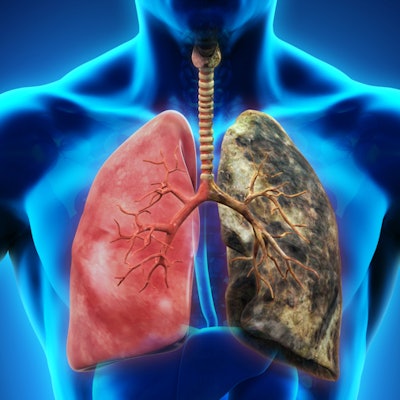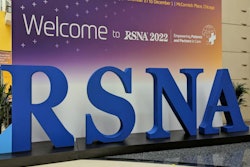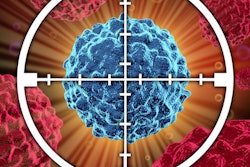
The cost-effectiveness of low-dose CT (LDCT) for lung cancer screening is improved by adding a plasma-based biomarker into the clinical evaluation, according to a study published May 24 in JAMA Network Open.
The findings suggest a way to make CT lung cancer screening not only more useful but also economical when it comes to patient outcomes, wrote a team led by Zixuan Zhao, PhD, of Zhejiang University in Hangzhou, China.
"Blood- and serum-based biomarkers are promising adjuncts to LDCT in lung cancer screening," the authors wrote. "Biomarkers with high specificity for early detection of lung cancer may help alleviate the problem of the high false-positive rate when using LDCT alone in a screening program."
China has one-third of the worldwide smoking population, and thus has a heavy lung cancer burden, the group noted. Although the effectiveness of CT lung cancer screening for reducing mortality has been established, the cost-effectiveness of different screening approaches needs further investigation.
One possible solution could be to determine screening eligibility based on the use of blood and serum-based biomarkers, such as a microRNA signature classifier (MSC), which can indicate the presence of cancer in the body. However, the researchers noted that MSC biomarkers are still in development and few results have been reported with them in practice.
To investigate the impact of an MSC biomarker on CT lung screening, Zhao's group conducted a model study that consisted of a simulated population of 80,000 Chinese individuals ages 50 or older with a history of smoking. The simulated patient group was based on a birth cohort between 1947 and 1971 so that eight sets of 10,000 would enter the study between the ages of 50 and 74 and be followed until death or age 79.
Using data from local medical insurance firms, the researchers evaluated the cost-effectiveness of low-dose CT lung cancer screening alone and its use with additional data from plasma-based biomarker testing. The model assumed that a positive MSC test resulted in a referral to CT lung screening.
The study's primary outcomes were life years, quality-adjusted life years (QALYs), and incremental cost-effectiveness ratios (ICERs). Strategies with a mean ICER of less than 212,676 Chinese yuan ($31,964) per QALY were considered cost-effective. The authors assessed a variety of screening strategies using a general framework of annual screening starting at age 50 and minimum cumulative smoking of either 20 or 30 pack years. (China's 2018 lung cancer screening guidance was annual LDCT starting at age 50 with a 20 pack-year habit, while its 2021 guidance was annual LDCT starting at age 50 with a 30 pack-year habit.)
The 2021 screening strategy of annual LDCT starting at age 50 with a 30 pack-year habit was not cost-effective compared with the 2018 strategy, translating to higher costs and fewer QALYs gained, the team found. The most effective strategies were either LDCT alone or LDCT plus biomarker data in individuals with a 20 pack-year smoking history.
| Comparison of lung cancer screening strategies by age | ||||
| Age at screening start and strategy | Cost (U.S. dollars) | Life years, in 10,000s | Quality-adjusted life years (QALYs), in 10,000s | Incremental cost-effectiveness ratios (ICER)* |
| Annual LDCT alone, 20 pack-year history | ||||
| Age 50 | $37.1 million | 133 | 133 | -26,039 |
| Age 55 | $34.6 million | 118 | 118 | -26,795 |
| Age 60 | $31 billion | 101 | 101 | -29,687 |
| Age 65 | $25.6 million | 82 | 81 | -39,002 |
| Age 70 | $24.7 billion | 60 | 60 | -56,880 |
| Annual LDCT with biomarker data, 20 pack-year history | ||||
| Age 50 | $35.1 million | 133 | 133 | -40,517 |
| Age 55 | $32.9 million | 118 | 118 | -44,883 |
| Age 60 | $29.5 million | 101 | 100 | -58,563 |
| Age 65 | $18.1 million | 81 | 81 | -121,641 |
| Age 70 | $17.5 million | 60 | 60 | -793,995 |
There are some barriers to adding biomarker data to LDCT lung cancer screening, as biomarker testing is not covered by medical insurance in China, and its cost can be double the cost of low-dose CT screening alone, the group noted.
"There is a need to provide bonuses for participants in the conjunctive screening strategy to ensure uptake of the screening program once plasma-based biomarker screening is included," it wrote.
The team also conceded that a limitation to the study is that it assumed 100% compliance with lung cancer screening guidance, when in truth, uptake in China is between 34% and 48% of the eligible population. But the authors hope the study results will boost lung cancer screening uptake by highlighting how it can be made more efficient and economical.
"The cost-effectiveness of lung cancer screening was improved when screening tools were expanded to include a plasma-based biomarker," the group concluded.



















